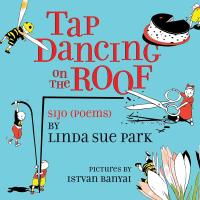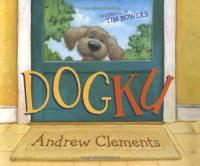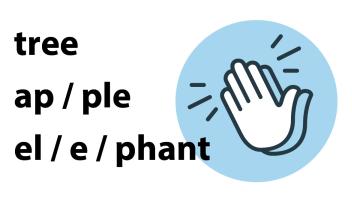As students progress in their literacy understanding, they move from reading and writing single syllable words (often with consonant-vowel-consonant constructions) to reading and writing multisyllabic words. Instruction often focuses on teaching different types of syllables (open and closed) and what occurs when syllables join together within a word.
Key Information
Focus
Appropriate Group Size
Why teach about syllables?
- Dividing words into parts, or “chunks” helps speed the process of decoding.
- Knowing the rules for syllable division can students read words more accurately and fluently.
- Understanding syllables can also help students learn to spell words correctly.
Watch a lesson: helping children clap or tap syllables in words (small group)
In this syllable segmenting activity, the teacher has the students clap out the syllables in the names of animals using picture prompts. (Durham District School Board)
Watch a demonstration of the “quiet yell” (whole class)
Monique Ealey demonstrates the Quiet Yell, a fun and engaging strategy that helps students practice segmenting and counting syllables in words. Ms. Ealey is a former teacher and current director of education and programs at the Mississippi Children’s Museum. (From our sister project, Reading Universe )
Watch a demonstration of “stomp and say” (whole class)
Former teacher and current Director of Education and Programs at the Mississippi Children’s Museum, Monique Ealey, talks about her fun and engaging “stomp and say” strategy to help students practice segmenting and counting syllables in words. (From our sister project, Reading Universe )
Watch a lesson on segmenting and blending syllables (small group)
Students in teacher Liz Quezada’s class practice segmenting words by pulling apart syllables and then putting them back together to form the word. They’re at La Verne Heights Elementary School in La Verne, California. (From our sister project, Reading Universe )
Collect resources
Marker activity
This activity, from our article How Now Brown Cow: Phoneme Awareness Activities, is an example of how to teach students to use a marker (i.e., token) to count syllables.
The marker activity often used for word counting can be adapted for use in counting syllables. Teachers can provide each child with tokens and two or three horizontally connected boxes drawn on a sheet of paper. The children place a token in each box from left to right as they hear each syllable in a word.
Multisyllabic manipulation
This example includes several activities and a chart of multisyllabic words. One specific activity from this page is the Multisyllabic Words Manipulation Game. Teachers can divide words from reading selections into syllables, write each syllable on a note card and display the syllables in jumbled order. Have students arrange the syllables to form the words. Multisyllabic words manipulation ›
Clapping games
Associating syllables with a beat can help students to better learn the concept of syllables within words. Here’s a clapping game to help young learners understand about dividing words into syllables. Basic words clapping game ›
Jumping syllables
This activity teaches student to separate words into syllables. Students move syllables around to create new “silly” words, giving them practice manipulating different sounds. Jumping syllables ›
More syllable activities
Find many more syllable activities developed by the Florida Center for Reading Research.
Teaching syllable awareness
Learn more about teaching syllable awareness in this skill explainer from our sister site, Reading Universe. You’ll find classroom videos, lesson plans, student practice activities, and more.
Differentiate instruction
For second language learners, students of varying reading skill, and younger learners
- Use pictures instead of words in activities for younger and lower level readers
- Include auditory and hands-on activities (i.e., clapping hands, tapping the desk, or marching in place to the syllables in children’s names)
- Include a writing activity for more advanced learners.
See the research that supports this strategy
Adams, M., Foorman, B., Lundberg, I., & Beeler, T. (2004). Phonemic Activities for the Preschool or Elementary Classroom.
Ellis, E. (1997). How Now Brown Cow: Phoneme Awareness Activities.
Moats, L. & Tolman, C. (2008). Six Syllable Types.
Children’s books to use with this strategy

Tap Dancing on the Roof: Sijo (Poems)

Dogku


